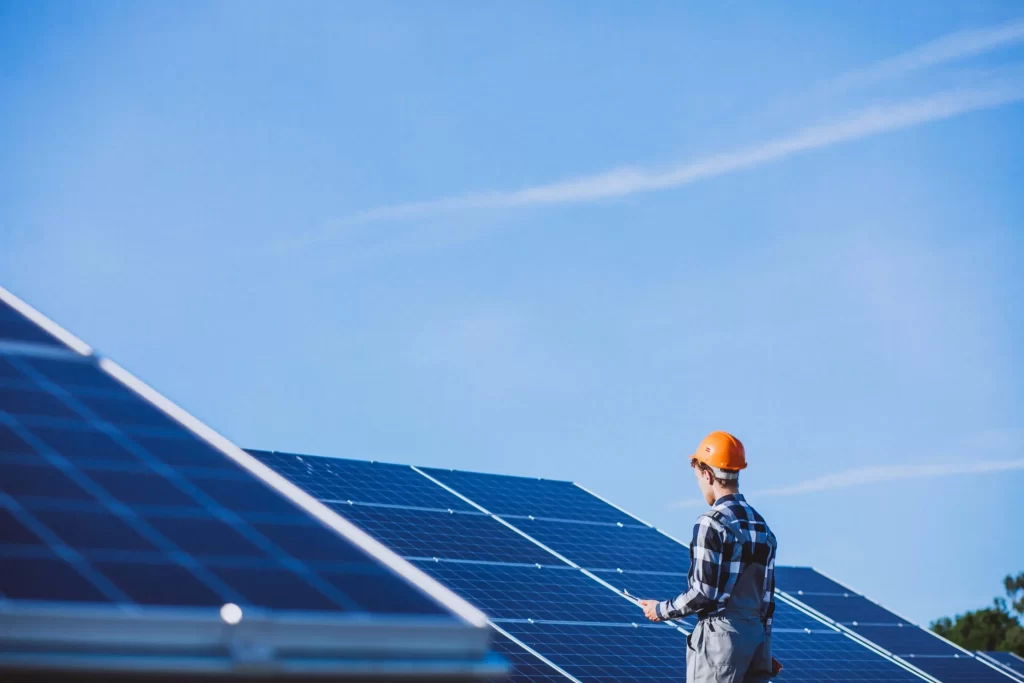
Solar panels convert sunlight into electricity and contribute to a better environment. With the sun’s energy, solar panel generates usable renewable electricity known as the “photovoltaic effect”. Moreover, the electrical current is consumed by plates and wires and after turning it into usable electricity sent to your home and appliances. This article will explain exactly how solar panels produce or generate renewable energy for your home and what is the working principle of solar panels.
Let’s start…
In simple words, solar panels contain many smaller units called photovoltaic cells, and it works by permitting photons, or particles of light, to knock electrons free from atoms, generating an outpour of electricity. Moreover, solar energy is directly converted to electric power in the solar photovoltaic system, making it far more convenient and suitable than thermal methods of solar energy conversion.
We all know that these days, solar cell technology is a rapidly growing power-generating technology in the world. It is because solar cells with a transformation efficiency of more than 20-24% are becoming obtainable everywhere.
Working Principle Of Solar Panel:
A solar panel is a semiconductor device that converts sunlight into Direct current power using the photoelectric effect, and all solar cells are photodiodes made of semiconductor material like silicon.
Solar cells work in three steps:
- Photons absorbed by the semiconductor material hit the solar cell in the sunlight.
- Negatively-charged electrons start flowing in the same direction to generate an electric current after knocking off from their atoms.
- A typical silicon solar cell’s maximum power is 4.75-6 W as it can produce up to 0.5 V and current up to 6 A.
Since the output of single solar is minimal, many solar cells are interconnected to form a solar module; a combination of solar modules is called a panel, and a variety of panels is known as a solar array. The voltage increases as the solar cells are connected in series. However, the current remains the same.
The major elements of a solar PV system are:
Solar Panel:
During sunlight hours, the panel converts electricity which charges the battery, but during the night or when there is no daylight, the current tries to flow in the reverse direction; this reverse process can damage the collections. Basically, to avoid this reverse flow, blocking diodes are used.
DC Distribution Box:
The solar power plant operator uses the DC Distribution Box to disconnect and connect the inward solar supply and battery terminals. Here an MCCB and a fuse of proper rating depend upon the power plant’s capacity, and the battery bank is used. The DC Distribution Box has two sections: first, the solar, and second Battery sections. Moreover, the DC Distribution Box is provided with a digital Ampere Hour meter to monitor the charging/discharging currents of the Battery.
Inverter:
Since the energy produced by a PV array is DC, an inverter converts it into AC power so that we can utilize it efficiently. The inverter unit with different safety devices ensures the system’s safety and functions with automatic changeover of load and available energy sources.
AC Distribution Box:
After getting AC power from the solar inverter, the ACDB or Alternative Current Distribution Box directs it to AC loads through the distribution board. ACDB contains the required surge protection device, SPD, and MCCB to rescue or protect the solar inverter from damage or heavy voltage.
Storage Batteries:
Storage Batteries are used storage of solar energy, which is the optional component of the Solar PV system. Thus, the work of a Solar PV system depends upon the battery storage system.
Battery Controllers:
Battery controllers manage the system in the case of off-grid plants which is optional and not used in on grid systems. It confirms that the charging of batteries is done correctly. Battery Controllers control the charging current and protect the battery from overcharging. Battery controllers continuously monitor the battery current, voltage, and temperature.
If you want to explore a wide range of products and services, such as solar on-grid systems, rooftop solutions, consultancy services, EPC, and O&M, you can visit Mint Solar in Lucknow. Mint Solar is a BIS-approved solar system provider with pan-India service coverage. Here you can find innovation, affordability, and reliability.
So what are you waiting for – Start saving money by investing in renewable energy!
Read More | 9 Reasons Why You Need to Go Solar Right Away